In the second part of our two-part series with Master Chief Douglas Healey, we jump into the back half of his career, during which we see Healey spend more time on a refitted USS Long Beach before taking assignments on two additional ships, as well as his rise to the position of U.S. Pacific Fleet Force Master Chief. We also get some rare straight talk on what the Navy needs most and on what it takes to be an effective leader, as well as so much more, from the veteran sailor.
So without further adieu, in the Master Chief’s own words, let’s begin:
Top Gun hits the theaters
Long Beach’s 1986 surge cruise with Ranger was to fill a gap in the deployment cycles caused by another carrier’s problems. Our group commander, CruDesGru 1 (Cruiser-Destroyer Group 1), ‘volunteered’ Long Beach for it because we were thought of as the readiest cruiser on the West Coast despite a number of Aegis (Ticonderoga class) cruisers in the Pacific Fleet.
We had just won the award for the best anti-air warfare cruiser in the Pacific Fleet. We were deployed to the northern Pacific Ocean and gone from home for 59 days because if we’d been gone for 60 days or longer it would have counted as a deployment. I believe Top Gun came out around this time because I recall going to see it when we stopped in Anchorage on our way home to San Diego. The only difference I noted was that everyone thought they could become a Navy pilot afterward.
Most of the movie watchers didn’t realize it was most likely a combat air controller on a ship like Long Beach that vectored Maverick to the MiGs! Regardless, I thoroughly enjoyed the movie, especially the flying scenes.
I think most F-14 jocks were a bit of hotshot. I remember my first cruise in 1976, when the aft lookout pointed out two smoke trails closing in on the ship at very high speed. Moments later, the two F-14s screamed past the forward superstructure and went vertical. I heard later that the CO was furious that we hadn’t picked up the jets on radar until they were upon us! This was before the installation of the AN/SPS-48 radar we received during the ship’s refitting in the early 1980s.
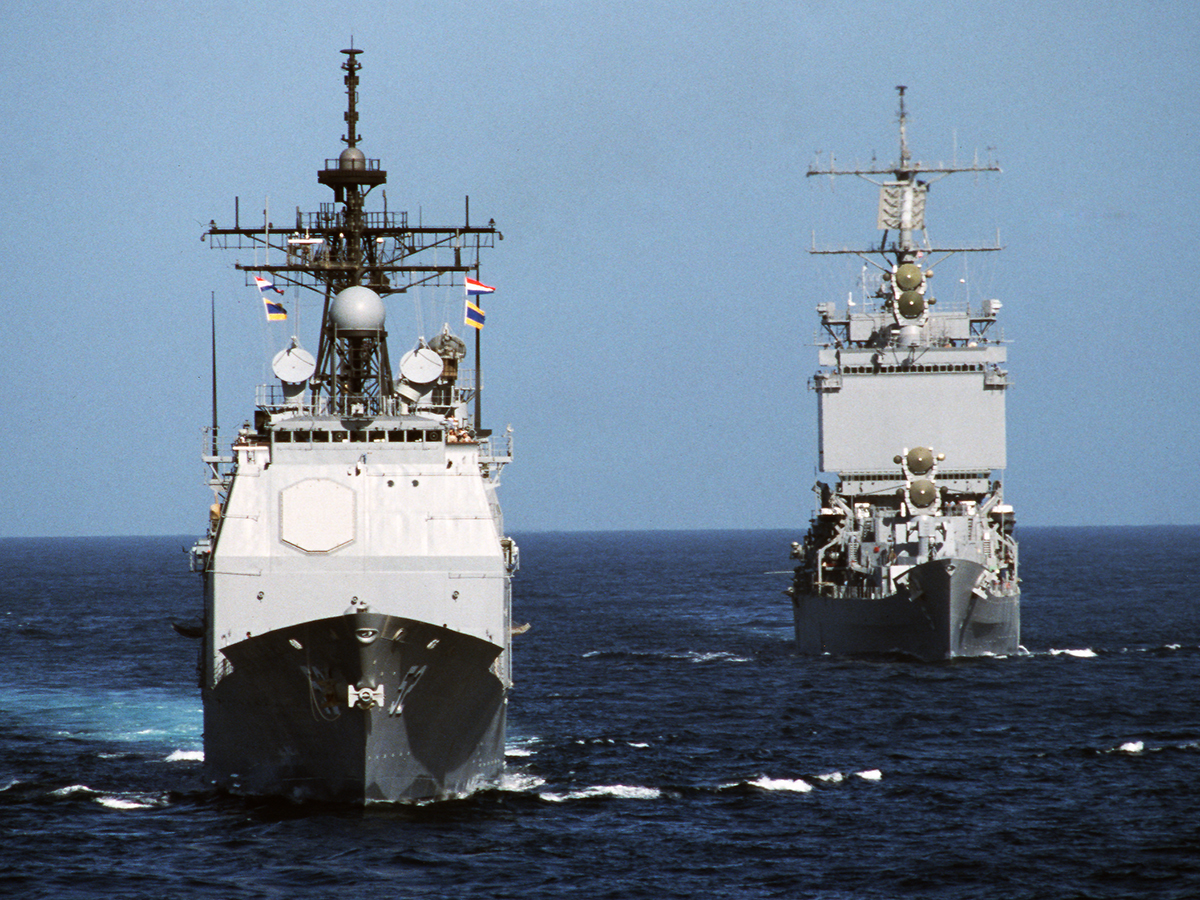
Swapping a carrier for a WWII era battleship
Long Beach’s deployment as the flagship of the Surface Action Group (SAG) alongside the Iowa class battleship USS New Jersey was a very interesting deployment. We made more port visits that previous cruises but every time we entered a port after Pearl Harbor, the Admiral would helo over to the New Jersey and ride it into port.
The New Jersey had an older Chief’s mess. A lot of the crew who had returned to active duty to bring ‘the Jersey’ back to life were still on it. I remember we had a get together at the Chief Petty Officer’s (CPO) Club in Pearl with their mess and at about 2200, their Command Master Chief got up and the entire New Jersey CPO mess returned to the ship. We were surprised, but like good Long Beach sailors, we remained at the club until closing time.

It was an unusual cruise because of the lack of organic air assets. We were supported by P–3 Orions whenever they were available but otherwise, the only aircraft were the helos (helicopters) belonging to a frigate, a Spruance class destroyer, a Ticonderoga class cruiser, and the replenishment ship in the group. Since Long Beach and New Jersey both lacked helo hangers, neither one had its own helo.
We never went anywhere at flank speed since the other ships in the group were all oil burners. I remember the papers in Hong Kong were impressed but I don’t think the Navy brass was too thrilled, especially the naval air contingent. I seem to recall hearing rumblings and references to when the Japanese sank Prince of Wales and Repulse.
It was interesting seeing a broadside fired from those 16-inch guns. I also recall that New Jersey spent a lot of time steaming with one shaft locked because of a problem. Ships, like all other machinery, do wear out from age. We hosted the New Jersey’s Cheng (Chief Engineer) to watch the way we conducted engineering drills and he said he was amazed. He claimed that we ran far more complex engineering casualty drill than they could.
The other memory from this cruise that stands out was the lack of mail. Without a carrier and its embarked CODs (Carrier Onboard Delivery planes), you don’t receive the same amount of mail nor the frequency of it. This wouldn’t be much of a problem in today’s internet age, though.
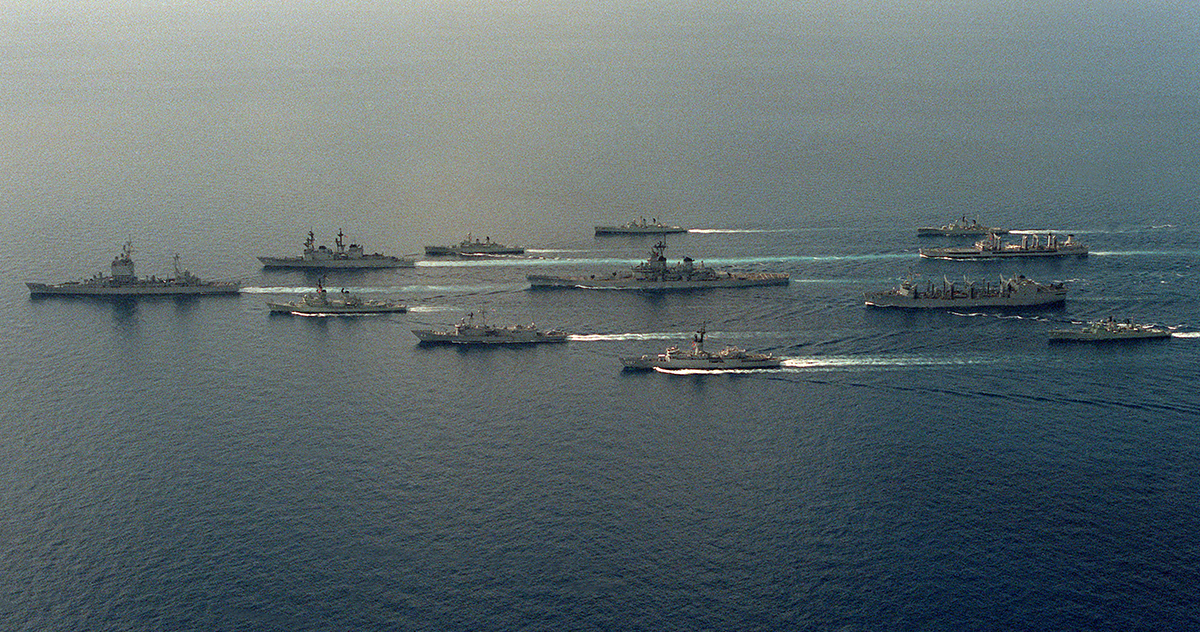
A Desert Storm rolls through the U.S. Navy
Although I was not stationed on a ship at the time of Desert Storm, this was the start of an increased operations tempo for the fleet. One of the first effects of the increased tempo was the start of a program called ‘stop loss,’ which was designed to retain personnel with skills that were in short supply.
The mood was generally upbeat and most of the people I came in contact with understood the need to drive the Iraqis out of Kuwait. The Navy had already been on an increased alert in the Arabian Gulf since the tanker escorts during the Iraq-Iran war. During my last deployment on Long Beach, we were near the mouth of the Strait of Hormuz while some of our destroyers shot up an Iranian oil platform after some belligerent action from Iran. I remember hearing the Iranians scrambled some of their F-4 Phantoms from an airbase and as soon as they lifted off we lit them up with our missile guidance radar and they decided to fly north, away from the action. I’m sure they were aware there was only one ship capable of taking them out from afar, the good ship Long Beach.
Another memory I have from that general time was after the Iraqis had been driven from Kuwait, I was being flown to Bahrain from the Nimitz along with some of my fellow NPMTT (Nuclear Propulsion Mobile Training Team) and the C-2 COD landed in Kuwait City to drop off some Kuwaiti VIPs. We were allowed to get off the plane to stretch for a bit before continuing on. The smoke from the oil field fires was so thick that I couldn’t see my own hand in front of my face! I remember thinking ‘this is probably taking a few years off of my lifespan!’ Those COD pilots were awesome for being able to land in that horrendous mess.

On a deployment aboard USS
Fox—a ship that we’ll discuss in a moment—we were tasked with intercepting any of the Iraqis trying to smuggle oil to circumvent the restrictions imposed at the end of Desert Storm. According to the rules of engagement at that time, if we had an unknown contact, an aircraft or vessel not responding to our challenges, close to within three miles of our position, we were allowed to fire at them.
At one point we had an airborne contact that was just skirting the three-mile boundary and not responding to our calls, so the CO had the ship close on it! As soon as we started to close, the contact identified itself as a helicopter from the logistics group based in Bahrain. I’m sure that helo driver got quite the thrill when his radar warning receiver started blaring because he quickly identified himself!
Making Senior Chief
My advancement to Senior Chief was the only time in my career when I didn’t get promoted the first time I was eligible. Since I was a nuclear-trained Electrician’s Mate, I was hampered by the number of quotas available. Still, I believe that because of my service on Long Beach, I was able to demonstrate the leadership to be selected for the rank of E8. Around the same time, I was in charge of the Long Beach’s Engineering Casualty Training Team and we earned our first ‘excellent’ overall on our Operation Reactor Safeguards Examination. We’d seen some of the newer Virginia class cruisers earn an excellent but I had been told by some that Long Beach was too old to be able to get an excellent grade, but we earned it. I believe it was because of that I was invited to serve on the CNSP/CNAP (SurfPac/AirPac) Nuclear Propulsion Mobile Training Team (NPMTT).
This meant that I would be training nuclear trained electrical operators on cruisers and carriers in the Pacific Fleet. I would be helping the ships prepare for their Operational Reactor Safeguards Examinations. I was also sent to Career Counselor’s School in San Diego so I could advise and assist Pacific Fleet nuclear trained enlisted personnel on their assignments and careers. This position required a lot of traveling throughout the Pacific Fleet operating area. I also got to know the Commanding Officers of the nuclear ships and most of the Engineering and Reactor departments on the ships, especially the key personnel.
Being a Senior Chief and part of the NPMTT, I noticed what I said seemed to carry more weight than before, even when I was a Chief. While on the NPMTT, I was selected for promotion to Master Chief the first time eligible again.

Once I had decided to make a career in the Navy, my goal had been to become a Chief Petty Officer like my father. Once I made Chief, my goal was to become a Master Chief like he had been and once a Master Chief I knew I wanted to be a Command Master Chief. Becoming a Command Master Chief means going through a selection process even more stringent than being selected for Master Chief. Since I was nuclear trained, I had to obtain a release from Naval Reactors.
By virtue of my having been a career counselor for the Pacific Fleet nuclear enlisted personnel and working closely with the nuclear-enlisted assignments at Navy Personnel Command, I knew that all of the sea duty billets for nuclear Master Chief Electrician’s were filled so that Naval Reactors (NR) wouldn’t have any concrete objections. Even when I was selected for promotion to Master Chief, I knew there were a limited number of quotas to advance and I knew who the other Senior Chief nuke Electricians were that were eligible, it was that small of a community.
I was sure I would be one of the top three and I ended up being number two since I had only 17 years service and the top guy had over 20 years service. I thought that once selected as a Command Master Chief, I would be sent overseas as I had not been stationed overseas because of being a ‘surface nuke.’ I told the assignment person that I just wanted a ship and where didn’t matter.
A few days later he called me back and told me I was assigned to the USS Fox (CG-33) homeported in San Diego! I was sent to the Navy’s Senior Enlisted Academy in Newport, Rhode Island from October until the middle of December of 1991. I was one of two Master Chiefs in the class and junior to the other one so I was the class vice president. I was excited to be going to my first tour as a Command Master Chief (CMC) and also found out that a Senior Chief in the class was going to the Fox as well.
After Christmas, I flew out to the Arabian Gulf to join Fox on deployment.
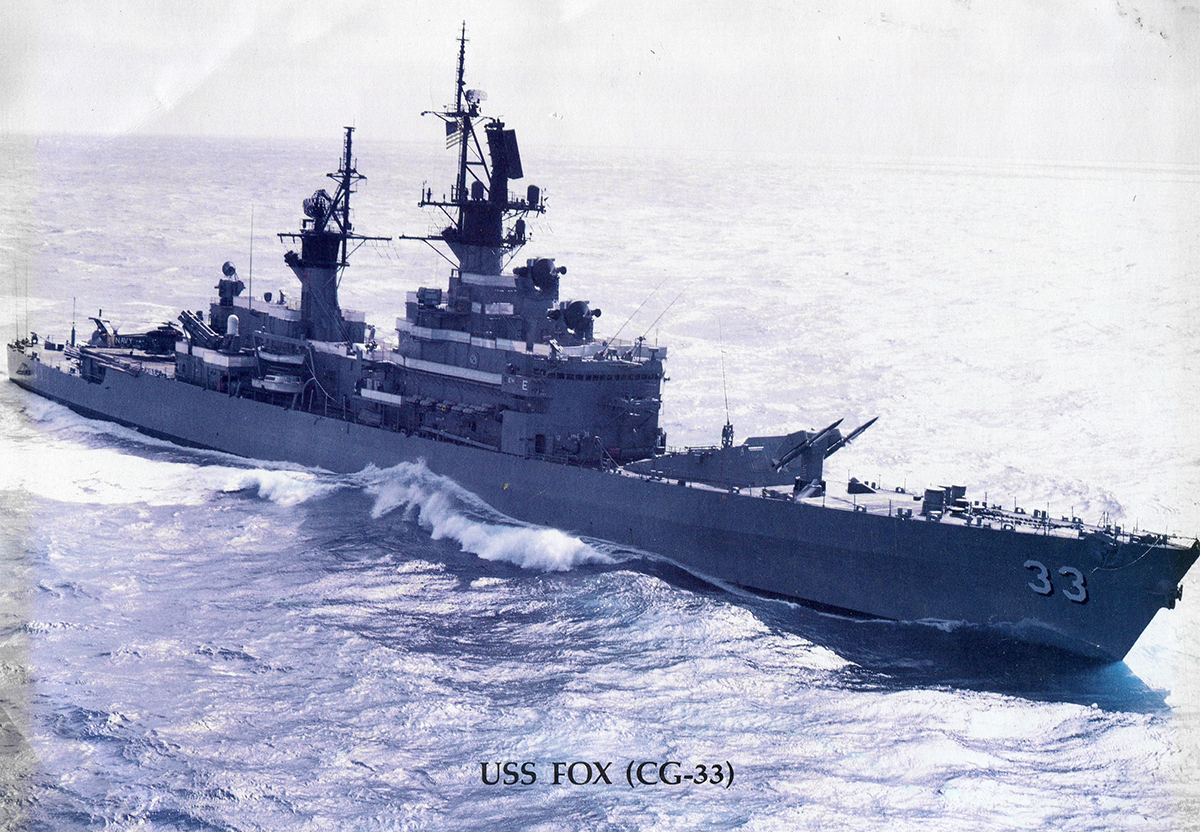
Welcome aboard the USS Fox!
Although Fox was twenty-five years old when I reported as Command Master Chief, it was exceptionally clean, in great shape and had a superb reputation in the Pacific Fleet. It was an incredible experience since the Master Chief who preceded me had been sent home to retire before I reported. I heard from the Chiefs in the mess that he was short-tempered and tyrannical. I’d learned to observe and not make snap decisions and sudden changes.
The first night underway from Dubai I was awakened at 2:30am by the announcing system calling for General Quarters because of a Class B (fuel oil) fire in number two fire room. It only took a couple of seconds to realize that was immediately below my berthing! The fire went out as quickly as it started. Apparently, some of the lagging (insulation) around the base of a fuel feed pump was giving off smoke and a watchstander in the space noticed it and when he peeled back the lagging there was a brief flash of fire. Another watchstander noticed the flash and called in the fire. There was no actual fire but the crew responded admirably.
I met with the Commanding Officer later in the day once we were at our patrol station in the Arabian Gulf. A few days later, during one of our daily chats, the CO asked me how it felt being on a conventionally fueled ship. I told him it wasn’t bad but the refueling every three days or so wasn’t any fun. I also commented that I hadn’t realized that it got so chilly in the Gulf in the winter.
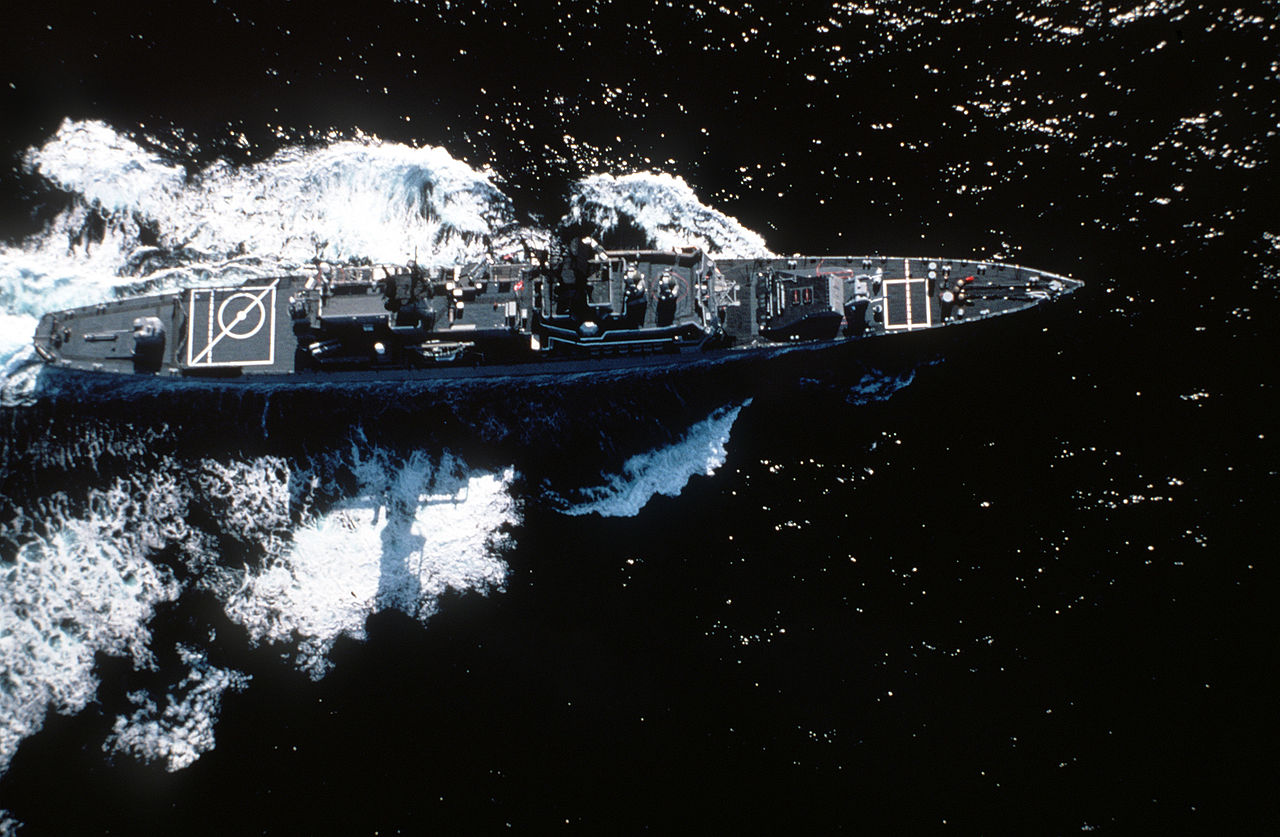
One major difference I noticed fairly quickly was that the non-nuclear-trained sailors I knew would object quickly and strenuously to policies they disagreed with and were not reluctant to let everyone know about their discontent. One of the first policies I changed was I observed the engineering watchstanders were not allowed to eat on the mess decks (dining area) in their fire-retardant coveralls but the engineering Chief Petty Officers ate in the Chief’s mess in their coveralls. I asked why the crew wasn’t allowed to eat in their coveralls and was told it was the Chief Cook’s policy.
I promptly informed the Chiefs that they couldn’t eat in their coveralls and was met with a loud outburst. After they calmed down, I asked the engineering chiefs if they were willing to work with me to change the Chief Cook’s mind. I spoke with the Chief Cook, the Food Service Officer and the Supply Officer and convinced them that the crew should be able to eat in their coveralls as long as they were not covered in grease and grime.
The junior enlisted engineers were on a five hours on and ten hours off watch rotation (three section rotation) and did not have an abundance of free time to be changing their uniforms between standing watches, working eating and sleeping. I didn’t make too many other changes other than altering the conduct of the CPO disciplinary review board. I changed it from being a butt chewing session to a fact-finding session. I don’t believe the engineers on nuclear ships worked any harder than those on the conventionally fueled ships, the nuclear-trained sailors just had better opportunities.
Fox bows out
On my second and last deployment aboard USS Fox, we had a port visit in Singapore. As was tradition, while in port athletic contests were set up among the sailors off of the various ships in the group. Fox’s basketball team handily defeated the one from the USS White Plains. As young men are known to do on occasion, there were words exchanged later at the Junior Sailors Club on the Singapore Naval Base. Apparently, after a while, a full-fledged fight occurred. The next morning the Commanding Officers and Command Master Chiefs of both ships were summoned to the Battlegroup Commander’s cabin on the USS Abraham Lincoln. We were told that the crews of both ships were confined to their respective ships.
In thirty years of service, this was the one and only time I was restricted to my ship. After a couple of days, the restriction was lifted and my Captain and I visited the White Plains where I was told by the White Plains’ Command Master Chief that he wasn’t surprised because his crew got into fights with other ships’ crews in their home port in Guam. This alerted me to the fact that young sailors were becoming more prone to quick flashes of violence over trivial matters. These quick leaps to violence are something I’ve noticed outside of the military as well.
Once upon a time, there might have been fights between crews, but they would pass quickly and then all would go for a few drinks together. Now it seems as though the anger remains and the level of violence appears to escalate rapidly.
I met with Fox’s enlisted leaders and promptly informed them that further fighting with other ships’ crews would not be tolerated and would adversely affect the supervisors’ performance reviews. We had no further incidents with other ships’ crews.
Fox was a well maintained and expertly operated ship. Fox’s last Commanding Officer, in particular, was an expert ship handler. We were pier-side in Manama, Bahrain on the inboard side of the pier and were supposed to get underway to meet up with the Lincoln. After waiting on the harbor pilot for an exceptionally long time, he ordered the ship to get ready to depart. The harbor pilot showed up, we cast off lines. The pilot wanted to wait for the tugs but the Captain told him to sit out on the bridge wing and smoke while he got the ship underway without the benefit of tugs.
He effortlessly got the ship underway without damaging the pier or the ship.
Later, when we were back in San Diego and prepared for de-commissioning the ship. The Captain had the numbers and the ship’s name painted in bright white, the way it used to be done. As we prepared for our decommissioning ceremony, we pointed out to the crew the Arleigh Burke class destroyer USS Curtis Wilbur (DDG 54) was preparing for commissioning at the end of the same pier. It’s the circle of life for Navy ships.

Saying Goodbye to Long Beach and the Navy’s nuclear surface combatant force
I was sad to see Long Beach retired. When I transferred from Fox, I was assigned as the Command Master Chief for Naval Amphibious Base Coronado. I was on travel when Long Beach was de-commissioned and unable to attend the ceremony. I was also not in San Diego when the Long Beach’s stripped hull was towed out of San Diego Bay on its way the Puget Sound Naval Shipyard. I was sent the pictures of the hull and it saddened me to see what was left of a once proud ship.
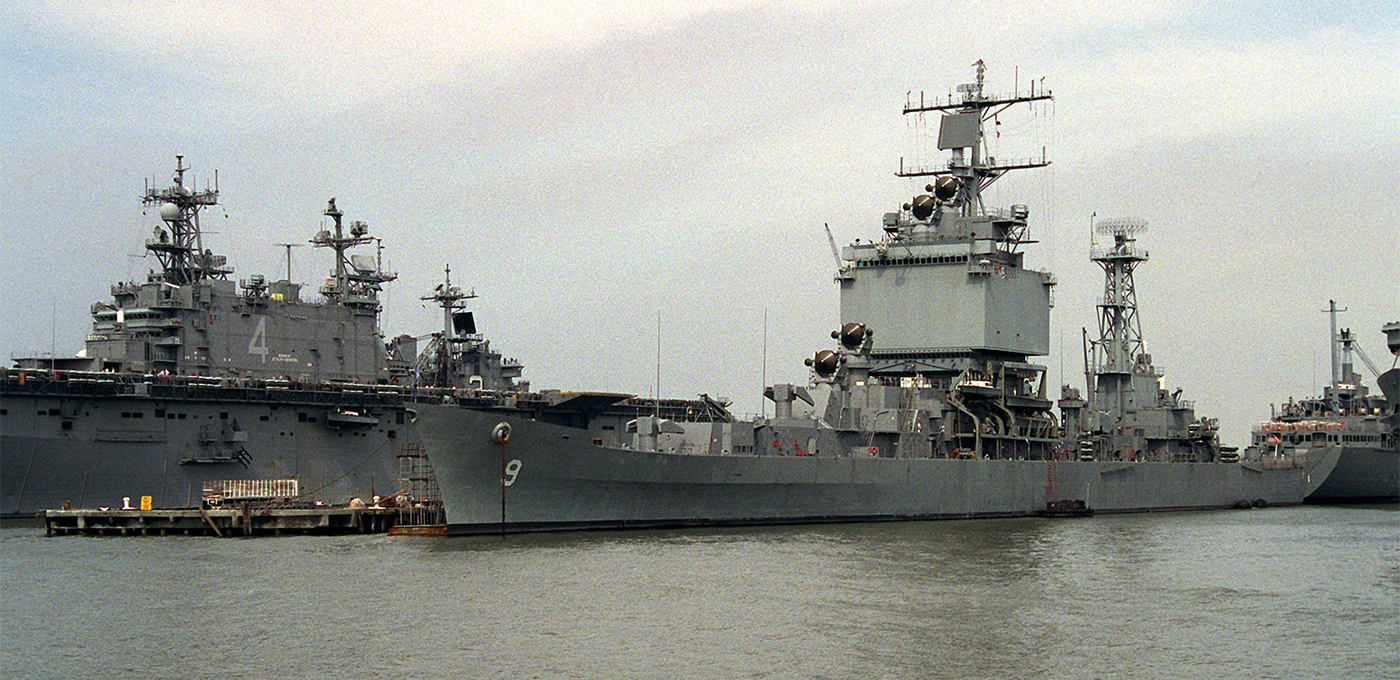
Since Long Beach was a ‘one-off,’ it would not have made sense to try to extend its life further. The hull may have been in good shape but a lot of the machinery inside had passed its planned life expectancy. The manufacturers for a lot of the equipment were no longer even in existence.
For the rest of the nuclear surface combatants, they could have served further, however, the cost of their refueling and the manpower required to keep them going was beyond what the Navy decided it could afford. The Arkansas had a crew complement of about 450, a Ticonderoga class cruiser about 370 and an Arleigh Burke destroyer has about 340, so a major factor is the cost of manning the ships, not just once but over the expected life of the vessel. The nuclear ships just weren’t efficient in that respect.

Back to the future
Helping to bring the Arleigh Burke class destroyer USS Higgins to life was a new experience for me as it was designed from the keel up to have a mix of men and women in the crew. Fortunately for me, I served as the base Command Master Chief at the Amphibious Base in Coronado which had both male and female sailors manning the installation.
Another major difference for me was that I had a hand in selecting the crew for Higgins. I noticed quickly that some of the other DDGs (guided missile destroyers) in the construction pipeline were filling some of the positions that we still needed to fill. I was told by the new construction desk at the Navy Personnel Command that we were already near our ‘allotted number’ of female crew members! I explained to the individual at the other end of the phone line that we had three types of berthing for enlisted sailors. We had ‘male’ berthing, ‘female berthing’ and ‘neutral’ berthing.
You may be wondering, what’s the difference? Male berthing has urinals in the heads (bathrooms), neutral berthing did not have urinals in the heads and female berthing didn’t have urinals in the heads and had two doors with a tiny atrium between the entryway.
We were also having trouble manning some of the middle-level enlisted personnel (PO2s or E5s). I spoke with the Captain and Executive Officer and explained that we could get sailors, but we would have to accept graduates right out of the technical training schools instead of getting an experienced PO2s from the fleet. They agreed it would be better to be fully manned but I had to convince my fellow Chief Petty Officers.
I met with the CPOs and informed them of the plan and there was some mild resistance. I explained to them that the only ‘bad’ habits their sailors would have would be the ones they, the supervisors, gave them. The end result was we sailed away from Bath Iron Works in Maine as fully manned with 348 sailors. We were told that Higgins was the first DDG they had seen sail away from the building yard with all billets filled.
It wasn’t much of a gamble as new construction ships are rarely thrown into the breach. There’s a bunch of hoops the ship and crew must pass through to be certified as fully operational. Higgins was commissioned at Port Everglades, Florida in April of 1999 and we sailed through the Panama Canal on our way to our future home port of San Diego. Along the way, we drilled repeatedly to ensure we would be ready for action if needed. It paid off as we excelled at our early inspections and certifications and I am sure Higgins’ reputation was a factor in my selection as the eleventh Force Master Chief for Naval Surface Forces Pacific (SURFPAC).
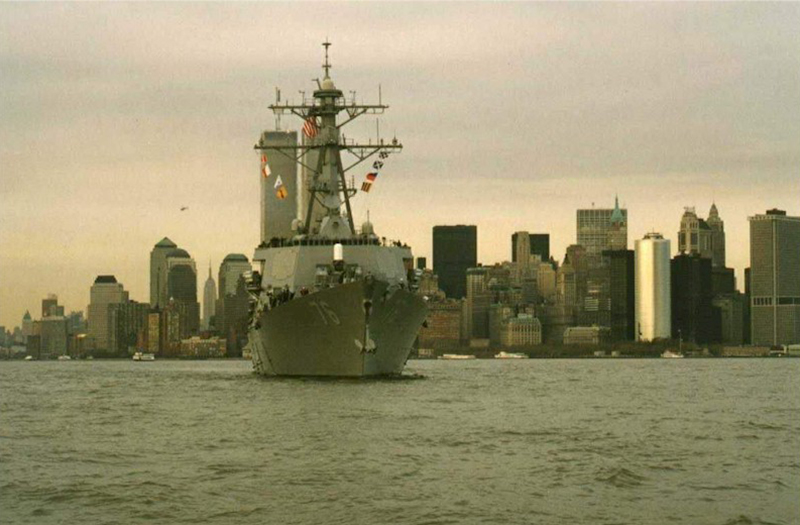
Force Master Chief
The SURFPAC Force Master Chief’s job description states “…serves as an adviser to the Commander on matters affecting enlisted personnel and their families” and is also a conduit between the Chief Petty Officer’s messes in the force and the Commander and serves as a member of the Chief Of Naval Operations/Master Chief Petty Officer of the Navy (CNO/MCPON) Senior Enlisted Advisory Panel.
The Force Master Chief works closely with the Fleet Master Chiefs and the MCPON in developing policies and procedures to recommend to CNO for matters affecting the enlisted force. As a part of the CNO/MCPON Senior Enlisted Advisory Panel, one item I was especially proud of was getting sea pay authorized for ranks E3 and below. Before this, a sailor had to be an E4 and senior to get paid sea pay. In my opinion, the junior sailors, especially E3s and below, are some of the hardest working sailors in the Navy and yet, if they are assigned to shore duty they could possibly earn more money than those assigned to a ship.
A shore duty sailor can be paid to not eat in the mess hall and even be paid to live off the base, whereas a sailor on a ship is expected to eat and live on the ship. The difference in money earned could be about $300 or more a month. The Admiral I worked for at the time told me, perhaps in jest, that he wasn’t in favor of E3 and below getting sea pay because it meant that ensigns (O1s) would get sea pay also. I replied to him that I didn’t care if ensigns got sea pay or not but that I felt the hardest working sailors should earn the additional money and I would fight to get it for them. Normally it takes a few years to get something like this approved but the Secretary of the Navy was able to find enough money in the budget to make it happen.
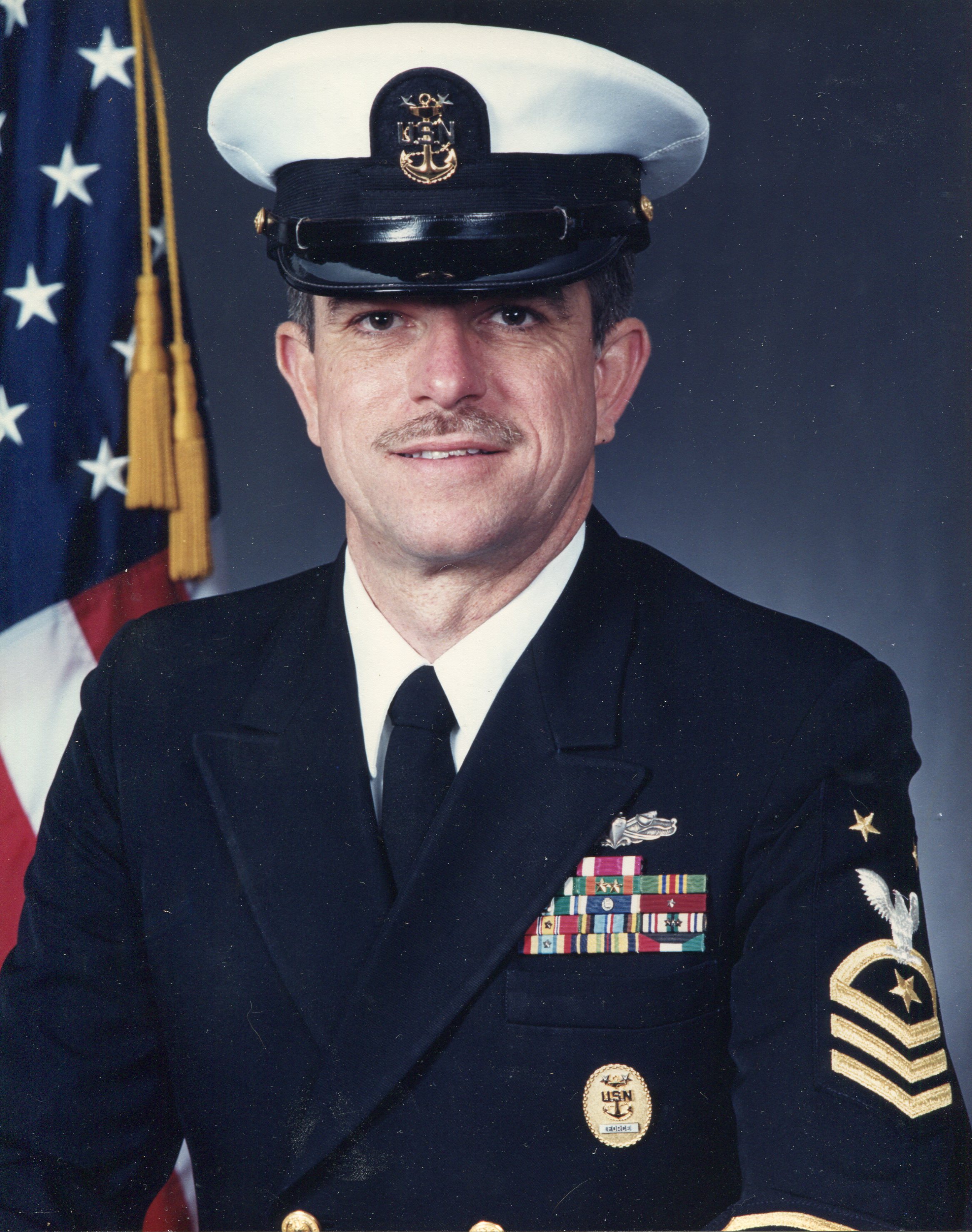
Another item I was proud of being a significant part of was the revisions made to boot camp. We were losing a significant number of young men and women to life-altering orthopedic injuries and needed to put an end to the losses. The Navy training Force Master Chief had a study that showed sailors marched as much if not more than the other branches of the Defense Department and the work shoes issued to the sailors were crappy. The Navy Special Warfare community (SEALs) had a flexible boot they used that was comfortable. We asked the manufacturer if they could make it with a steel toe and were told it was possible. Also, the ‘running’ shoes issued to the recruits weren’t very good and we were able to switch to some made in the USA by New Balance (which have an ‘N’ on the sides as a bonus) for physical fitness training. We also made other changes to the training provided to recruits to improve the quality of sailors reaching the fleet.
Making room for the Navy’s next Master Chiefs
Retirement and moving on is almost always a challenge, however, you must remember I was promoted to Master Chief with only 17 years in the Navy and there can only be a limited number of Master Chiefs in the Navy. I believe the limit is about one percent of the entire enlisted force, so from the time I was promoted until I retired, I limited the number of Master Chief spots that were available for others seeking promotion.
If it were possible and I could have moved into a position where I could have been effective, I might have considered asking to stay in the Navy but it was time for me to move on to the next phase of life. After retirement, I went to college and moved away from San Diego.
Five quick and interesting facts about USS Long Beach
- It was built keel up as a cruiser and was originally considered for launching intercontinental ballistic missiles ICBMs before the nuclear ballistic missile submarines (SSBNs) were proven successful and was later considered for launching the Regulus cruise missile.
- The box shape of the forward superstructure was for an early form of phased array radar that swept 360 degrees electronically rather than having a rotating radar antenna.
- Long Beach had teak decks in the forward quarter deck area and a Marine detachment like the cruisers and battleships of World War II.
- The ship was originally designed with an all-missile armament, the two five-inch gun mounts amidships were put on after initial ship’s sea trials.
- At one time, Long Beach was one of the tallest ships in the Navy. Before a refit in the early 1980s, the ship was too tall to fit under the Coronado Bridge in San Diego. When Long Beach was on plane guard station astern of a carrier, the landing pattern for pilots had to be altered because of the ship’s height. It was so tall that when you were on the bridge, you looked down on the flight deck of an aircraft carrier.
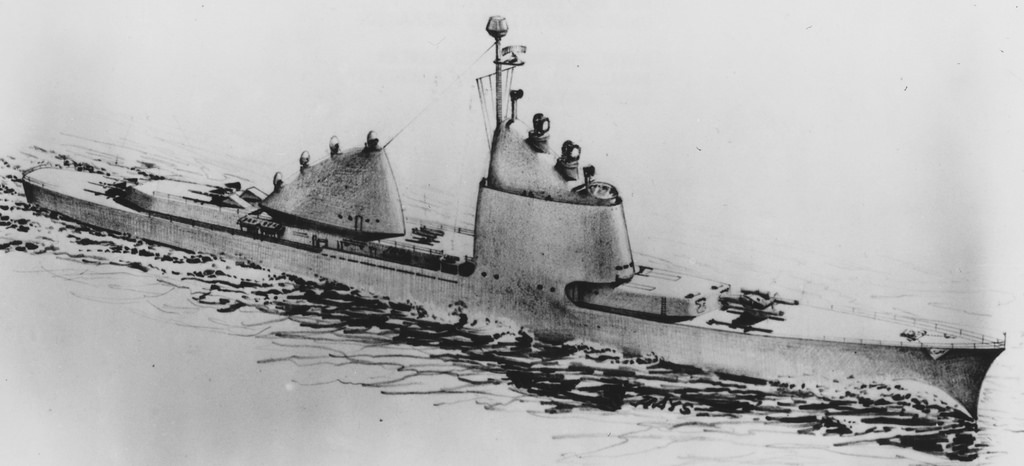
A troubled fleet
Our Navy’s current inventory of ships is insufficient to meet the demands being placed upon the force. The surface force ship construction and maintenance budgets have been woefully inadequate to meet the Navy’s requirements. I was told by an admiral that for years the surface ship maintenance budget has been understated and then the understated budget has been underfunded.
It would seem to an outside observer (which I am) that the Navy doesn’t seem to have a well thought out plan to modernize and maintain the fleet it already has. Too often, the Navy’s shipbuilding plans would appear to be driven by rewarding congressional districts and corporations instead of meeting the nation’s needs and its national requirements. A lack of foresight for designing, developing and bringing new ships into the fleet seems to be a major factor as well.
The Littoral Combat Ship is coming online without all of the mission modules to meet the Navy’s operational requirements for the ships and the Zumwalt class would appear impressive to the uninformed but it has guns without a projectile to shoot. The only currently successful shipbuilding program is the Arleigh Burke class destroyers, but just like the carrier air wings today, it looks like we’re headed toward a surface combatant fleet comprised of one type (Super Hornet).
We cannot have all our surface combatant force made up of a single ship design, that being DDG-51 Arleigh Burke class. The newest Ticonderoga class cruiser, USS Port Royal, was commissioned in 1994 and there was no follow-on cruiser design. The newest frigate, USS
Ingraham, was commissioned in 1989 and de-commissioned in 2014. Clearly, there’s been a lack of foresight in surface combatant design and development.
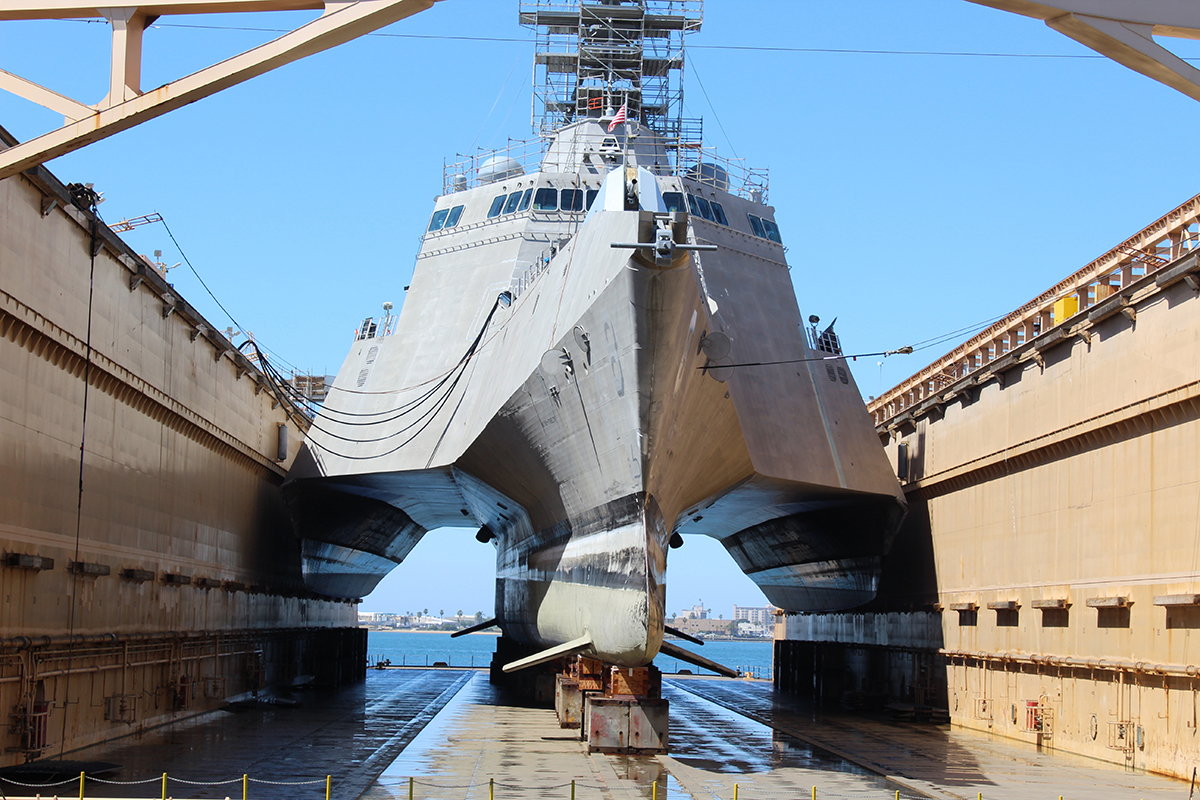
Russian Nuclear Cruiser Counterparts
I do not recall any discussions about the Russian Kirov class cruisers among Long Beach’s crew during my time stationed on that ship. During my first tour on the ship (1975 – 1978), the Kirov was not operational in the Pacific and we saw more of the Kynda class cruisers in the then Soviet fleet. Our main concerns were the numbers of weapon systems on each Russian vessel. We learned upon the collapse of the former Soviet Union the main reason for the volume of weapon systems on Russian ships was to ensure that one of them would work.

Safety of nuclear-powered fighting ships
Regarding the safety of the naval nuclear power plants, while all former sailors sign a debriefing notice regarding what can and can’t be released, I can unequivocally say while I was serving, we did not have any ‘sketchy’ moments. On the contrary, I remember as a newbie thinking that some of the safety precautions seemed to run contrary with the mission of a warship. Later in my career, I realized there were exceptions for battle conditions.
Both enlisted and officer nuclear-trained personnel go through extensive, rigorous training before they ever set foot on their first ship or sub. Even though it was 1950s technology, the Long Beach’s reactor plants were very safe. The crews train constantly to prepare for unexpected casualties. I do not remember any close calls.
Enterprise had the severe flight deck fire in January 1969 and the nuclear plant was never in danger. Without going into classified material, there are systems designed to put the reactor plant into a safe condition if the worst occurs. The Navy has had two subs sunk, Thresher and Scorpion and to my knowledge, there hasn’t been a problem as a result. Granted, anything made by man can fail at any time, it is the quality of the training received by the personnel operating the reactor plants that is the best defense we have against a major issue with the nuclear plant.
The Navy also has a rigorous inspection process that nuclear ships go through at least annually. The inspections thoroughly evaluate the material condition of the reactor plant, the knowledge level of the nuclear operators and their readiness to respond to casualties. The casualties are simulated, but the level of the training is such that the simulations are very realistic.
The ability of the ship’s engineers to conduct the casualty control training is also evaluated. The first concern evaluated is do the ship’s engineers safely operate the reactor plant? The nuclear-trained personnel are required to know the immediate actions necessary to put the plant in a safe condition and then check the established procedures for follow up actions as required. When the nuclear propulsion program was established, Admiral Rickover reportedly stated that “he could train monkeys to flip switches” when needed but he wanted his operators to understand how their actions affected the plant operation.
Overall, I believe the Navy’s history of safe reactor plant operation speaks for itself.

The Navy’s ship collision problem
For as long as I can remember there have been collisions between ships. I think the disappointing aspect of the recent collisions among 7th Fleet surface warships is an apparent over-reliance on technology today. I do not understand why it appears that neither ship had lookouts with their ‘mark 1 mod 0’ eyeballs available to spot other ships in the vicinity but instead seemed to rely upon radar or other technology.
I wonder if, in a way, to reduce the ship’s manpower, the number of lookouts were reduced, maybe even to zero? I think the Navy should immediately require, as a minimum, port and starboard lookouts be stationed. Regarding the operations tempo of the Pacific Fleet’s forward deployed naval forces, this is a situation that’s been known for quite some time.
Additionally, as I stated before, surface warship maintenance has been underfunded for quite some time. These are not new problems and it is a fallacy to think that anyone above the level of the respective destroyer squadron commanders are seriously being held responsible for the situation. Sure, the 7th Fleet Commander had to retire earlier than he’d planned and the same goes for the Pacific Fleet Commander, who might have been selected for overall Pacific Command if not for the collisions, and the SURFPAC commander retired as well, but realistically speaking, the retirement of three or four star admirals is not a punishment. The bottom line here is that our Navy, especially the surface forces, need to get back to basics regarding seamanship.
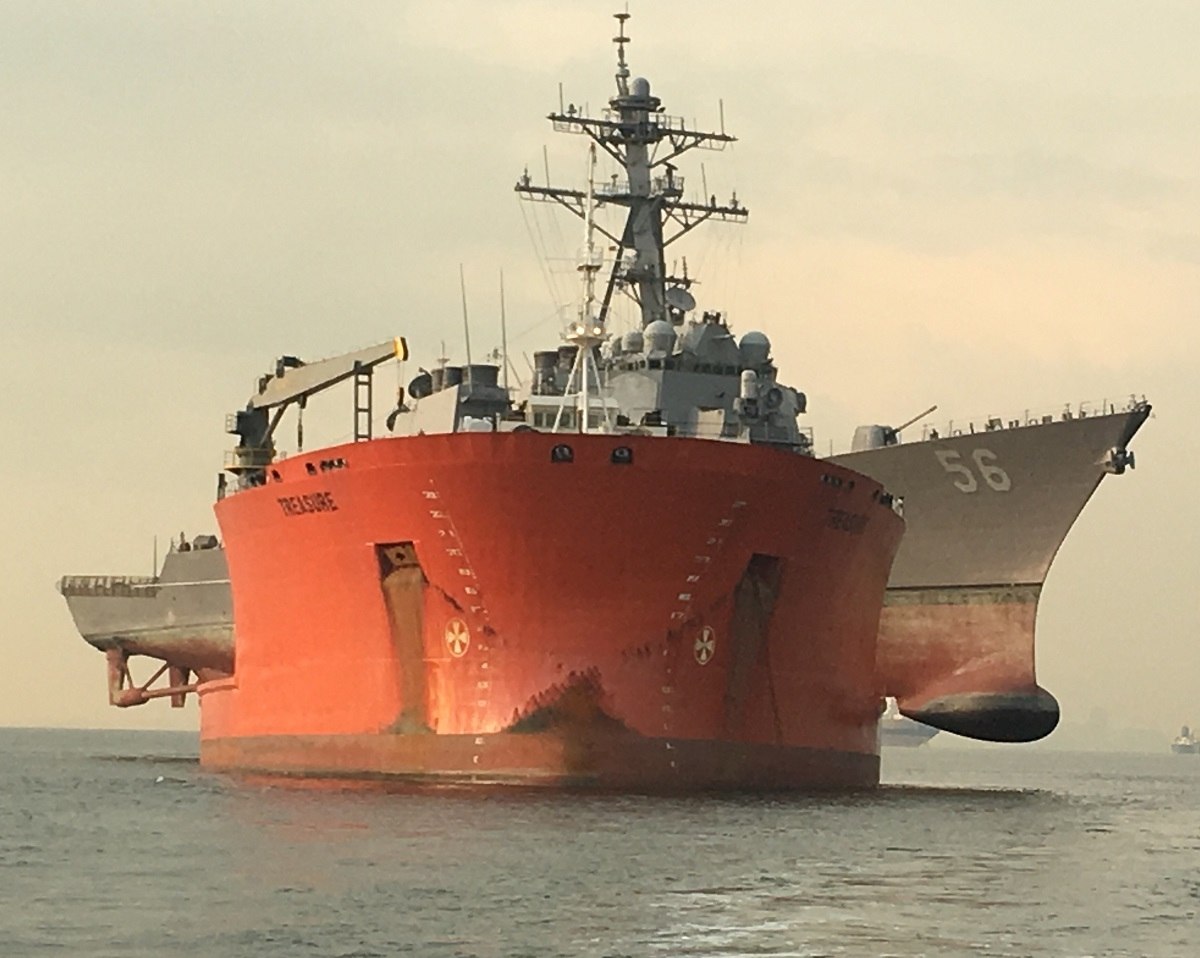
Recruitment and today’s Navy
Recruiting has traditionally been a challenge for the military, especially when the economy is booming. It is challenging to locate, recruit and train the sailors needed to man the Navy of today, much less tomorrow’s Navy.
The challenge becomes even greater when we consider that fewer future sailors have been around someone who served. We also have leaders that have not served and do not always have an understanding of what it takes to man a carrier battlegroup. One program that was in existence when I was at SURFPAC was called ‘Leaders To Sea,’ where educational and business leaders were sent out to ships operating in the San Diego operating area to see how their Navy performed at sea. I believe through programs like that and incentives provided to Recruiting Command it is possible to meet the Navy’s goals for recruiting and retaining quality personnel to meet the manning requirements.

Words of wisdom for prospective sailors
Talk to family members and friends and if possible visit a Navy command and see how it operates. I think that a fair number of young men and women still have ‘seeing the world’ as one of the reasons they choose the Navy over say the Air Force. Future sailors should all be aware that they can’t all be Maverick in Top Gun or on a sub like the new film Hunter Killer and although the star of the television show The Last Ship is a flight III Arleigh Burke class destroyer, they aren’t most likely going to be chasing a viral cure all over the globe. I just I hope they enter the Navy with some goals in mind and do their best to pursue those goals.
Three basic things that would result in a more effective Navy today
- One of the things that made our Navy great during the Second World War was its ability to fall back on the training, especially damage control training the sailors received. Technology is important but the basics such as seamanship and damage control are very important. The Navy needs to really focus on these basics again.
- There should be a fully cohesive plan for modernizing and maintaining the fleet.
- Listen to the sailors, a time-honored saying in the Navy is ‘ask the Chief.’ I would extend it to the rest of the sailors as well.

Three key elements that make a great leader, according to a Force Master Chief
- One of the best elements is the ability to listen. I was told years ago there was a reason that we were given two ears and two eyes but only one mouth. Listen to your people and observe them. Realize they want to do the best job they possibly can when given the opportunity. I was fortunate to have served with some of the best natural leaders and I watched and learned from them continuously.
- People need some time to decompress. Encourage your people to take time to get away from the job from time to time. They will usually come back refreshed and ready to excel even more. Also, pay attention to the interaction young people have with their shipmates and families. This can be an early indicator if there are problems ahead for them.
- Recognize your own weaknesses and strive to minimize them. Remember that life is a learning process itself. Also, proper delegation not only eases your burden but also gives your people opportunities to excel.
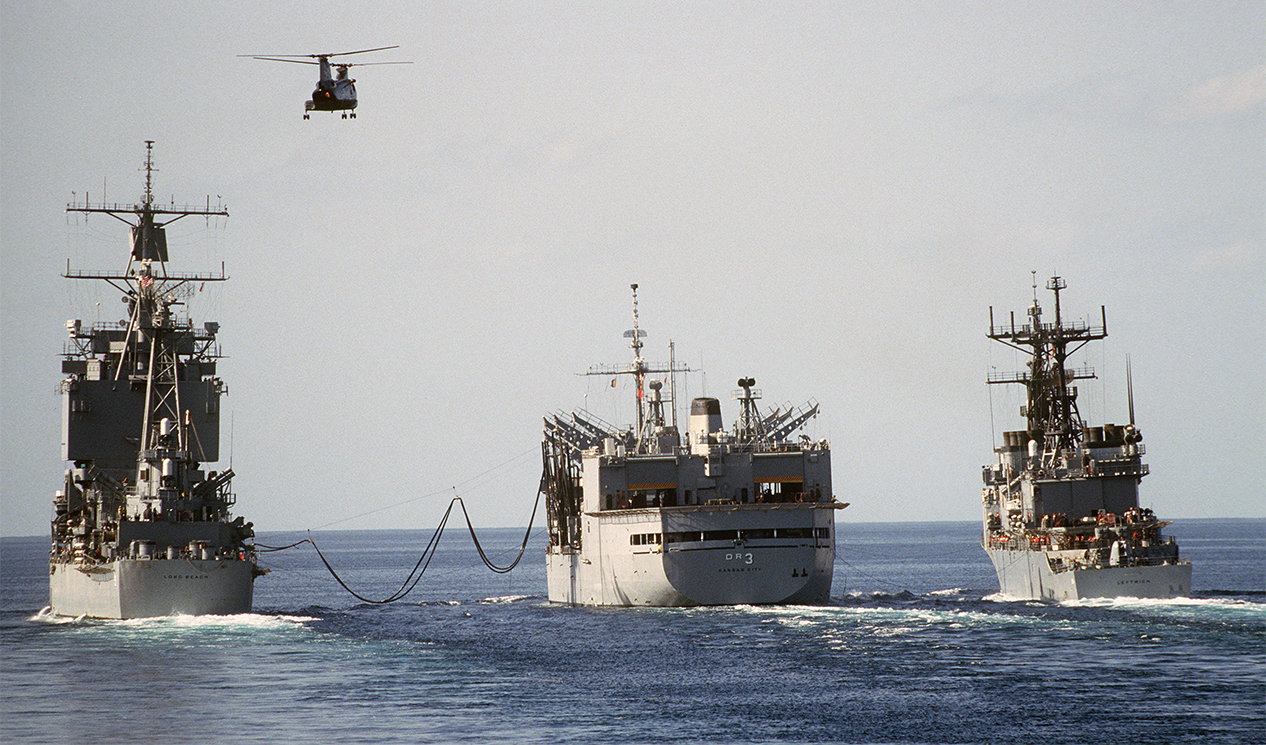
Contact the editor: Tyler@thedrive.com
